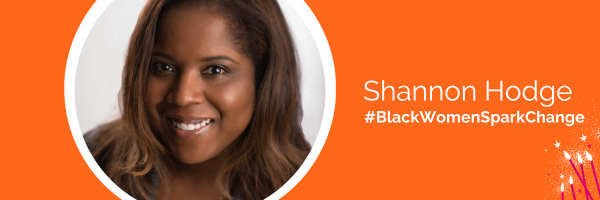Shannon Hodge’s Passion for Education Reform Impacts Thousands of Students

When she was in first grade, Shannon moved into a new neighborhood and her interest in education was sparked. Shannon’s parents chose the house because it fed into a stronger high school than another house they had considered. With that choice, they knew Shannon would have greater opportunities and more rigorous academics.
“I always wonder what would have happened if they picked the other house,” Shannon says. “Where would I have been?”
Recognizing the education gap
Shannon flourished in school, though she was quick to notice the lack of diversity in AP and honors classes. That inspired her — she dove into college ready to study education so she could, later, focus on fixing this critical issue.
“I did an undergraduate teacher education program, got my teaching certification, and dug into the role that education plays in our society,” Shannon explains. “Both the role that we think it plays, and the role that it actually plays.”
She also completed a guidance counseling master’s program and got a job in an Indiana school, where she was the first black faculty member. This, she notes, was during the No Child Left Behind initiative which leaned heavily on test-based school accountability to determine performance and quality — and schools that missed the mark were penalized. One day Shannon found herself administering English tests to immigrant students who didn’t speak the language at all, because of No Child Left Behind demands.
“It was a graduation qualifying exam,” Shannon explains. “I stood in the cafeteria with dozens of students just looking at this test, like ‘What is this?’ I didn’t get it — clearly something broken.”
A shift towards policy-making — and a nod from Justice Ginsberg
Seeing the students’ confused faces drove her in a new direction: policy-making. With an eye on advocating for underserved students Shannon headed to law school and, after, became an education attorney in Washington D.C. Her work centered on education reform and included writing an amicus brief for a Supreme Court case.
“Justice Ginsburg cited my brief in her dissent,” Shannon says. “So that was my crowning accomplishment.”
Shannon continued to drive change in education, diving in on a number of hurdles and much-needed reforms. She also worked with court-appointed receiver Josh Kern to save a charter school that was on the brink of termination.
“Options Public Charter School served over-age and under-credited students who had emotional and behavioral challenges, and students who had attendance and truancy issues. We felt like the school needed to stay open at least for another year in order to find better placements for those students.”
Creating a new charter school environment
The plan was to keep Options open for one more year, then send students to new schools. During that year, Shannon took on the executive director role, interviewing faculty and ensuring high academic and accountability standards for her students — students, she realized, weren’t likely to even try attending a new school, if assigned.
“They had already been through two, three, four, five, six other schools in the area,” she explains. “They weren’t going to look for another school. They were going to quit.” Shannon resigned from her law position and became a full-time administrator at Options.
During Shannon’s tenure, Options thrived and within the year, she was approached about opening a new charter to replace Options. That school — Kingsman Academy Public Charter School — opened months later, in July 2015.
“With my work as an education attorney, and then with running Options, I knew I understood what the students needed,” she says. “And I knew I had a team who could do for those students what had been promised, but hadn’t been done.”
Shannon spent nearly six years at Kingsman before turning the executive director role over to her co-founder. Now, she’s exploring what comes next — but whatever it is, it will be focused on advocating for students.
“I would hope, whatever this work is, whether it’s in charter schools, whether it’s in the classroom, whether it’s with assessments, that we really, truly figure out how to serve our students. My education path should be available to all — it should be more the norm.”
